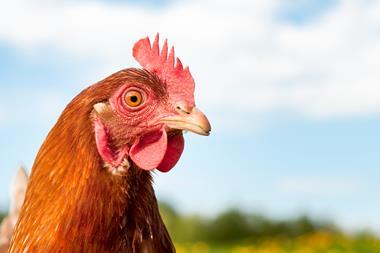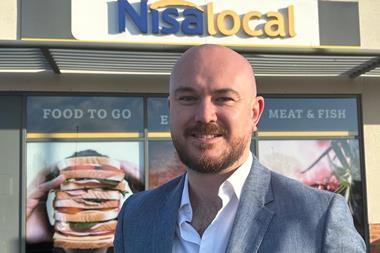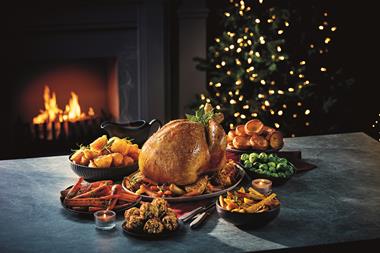Food manufacturers have enjoyed a particularly profitable 2005 to 2006 with margins hitting a healthy 9.5% compared with 9.1% in last year's figures. The increase is the result of a slight easing in the ultra-competitive battle between the major food retailers, according to The Grocer 150 Index 2006 compiled for The Grocer by OC&C Strategy Consultants.
Luke Jensen, head of the consumer and retail practice at OC&C, says: "Intense competition in 2004 meant that the profitability of food companies dropped and retailers were stagnant at best. Only consumers benefited. But the pressure has eased a bit and retailers and manufacturers have gained."
However, this overall improvement hides the fact that wide variations in performance could be found among the top 150 companies, he says, citing Golden Wonder, which went bust. There is certainly a marked difference in the performance of different-sized companies.
The top three players in the index improved their margins, from 12.2% last year to 13.5% this year. This helped Cadbury Schweppes maintain its number one spot, which should provide some solace after last week's product recall. Meanwhile, the margins of companies with a turnover of less than £500m grew from 5.9% to 6.3%. However, the margins of companies with sales of more than £500m (excluding the top three) slipped from 9.6% to 9.4%.
Among them is Northern Foods. Although it managed to hold on to its eighth place in the table, it only managed to increase its margin by 0.1% to 7%. Adding to its woes was a sales dip of almost 5% to £1.45bn and an operating profit decline of 4% to £102m.
This performance prompted the company to announce recently a change in focus. Pat O'Driscoll, chief executive of Northern Foods, said: "The new group will be targeted on fewer, higher-performing product categories. This will reduce complexity, drive improved performance, earnings and cashflow, and create a simpler, more competitive and resilient business."
Northern is representative of many larger companies that have decided to "choose their camp - private label or branded", says Jensen. Uniq has also undertaken a disposal programme to position itself as a specialist producer of ready meals for the supermarkets. These sales contributed to a fall in both turnover and profit in the index.
Roger Partington, board member of Grampian Country Food Group, says that this is a difficult balance to strike, particularly for large companies: "Scale is very important so you need to be either in branded or own label. It is difficult to keep a foot in both camps. Northern has certainly found this to be the case."
A focus on own-label production for the supermarkets has helped Grampian attract increasing business from these key customers as they increase their exposure to own label goods. The company has moved up one place in the index to fourth position with sales growth of 8.4% to £1.85bn. It has also increased its profits by a hefty 33%.
The company has also benefited from the increasing demand for more convenience products such as part-treated (added flavourings) foods that provide a "mechanism to increase the unit cost", according to Partington.
Underpinning this are some major investments in manufacturing facilities that make it possible for it to supply its products to the supermarkets at very competitive rates.
"The food business is remarkably competitive because of the supermarkets wanting the best possible value. We've been successful in providing the products that our trade customers want and our modern plant enables us to keep our costs low," he says.
The size of the margins show just how competitive the own label market is. At Grampian, it stands at 2.2%, which although a significant improvement on the 1.8% of last year, is much lower than those enjoyed by the branded players. Their margins average 13.5% compared with only 5.4% for own label producers.
Jensen says: "Own label is less profitable than branded but if run efficiently you can get a good Return On Capital Employed (ROCE). This can be achieved by improved run lengths, better partnerships with supermarkets, and a focus on best-sellers and efficient sales teams."
Although the profitability of branded manufacturers falls to 9.1% for those companies with sales of less than £500m, margins of smaller own label producers are actually higher, at 5.8%, than those of their larger peers.
Not only are these smaller own-label companies enjoying this improved margin but they are also achieving significantly better growth rates than their larger peers. Their turnover has increased by 7.8% compared with 0.4% for larger own label producers. They are also achieving a better ROCE at 22.3% compared with 16.7% for the larger companies.
It is all about specialisation, says Jensen: "The large players have broad ranges but small producers are focused on a tight set of products. There is evidence that the supermarkets have sought out these niche players to source own label products and to help them innovate."
He believes that innovation is primarily being driven by the supermarkets (through own-label) and that the branded manufacturers have not been delivering in this department. However, he expects this to change and says that the chilled category, where much of the innovation has been concentrated, is forecast to grow by nearly 40% by 2010, thereby providing plenty of opportunity for the brands as well as the own label products.
Steve Newiss, vice president of global customers at Kraft Foods International, agrees that things are changing. "We were nervous about sharing innovations with retailers as their own label would then be out two weeks later. But it's to everybody's benefit to bring out innovative brands and so there is now a maturity in the relationship that suggests things could be positive for brand innovation."
He also believes that the high pricing of branded goods has provided an even greater opportunity for the growth in own label sales, but again, he is predicting change.
"We were asking too much for brands. Brand premium is taken in the volume [at Kraft], not in the brand, and this gives less reason for people to go for own label. Manufacturers are now being more realistic," he says.
While the major brand manufacturers have been prevaricating, the supermarkets and smaller players have been busy building relationships and sales. They have undoubtedly been helped by some major trends that have propagated innovation such as the increased consumer demand for premiumisation and the emergence of organic and healthy eating initiatives.
The market for organic has been growing rapidly - at 12% per year through 2003 to 2005 - and further growth is forecast. Much of this has been driven by own label in the supermarkets, which command 82% of all organic sales - a much larger percentage than their share of the overall food market.
Among the beneficiaries is Yeo Valley Organic, which has moved from 121st place in the index to 79th spot with an increase in sales of 94% to £120m. It has also increased its operating profits by 200% to £6.7m. Although this reflected the acquisition of Rocombe Farm Fresh Ice Cream, the company still achieved impressive organic growth of 17.6%.
Graham Keating, director of communications at Yeo Valley Farms, says organic has been the domain of the smaller operators because they have been far more flexible than their larger rivals in adding organic production lines to their existing non-organic manufacturing operations. And the sourcing of organic produce in large volumes has also been difficult.
This flexibility has enabled Yeo Valley Farms to operate successfully in both the own label and branded markets - with 60% of its sales derived from own label brands such as Sainsbury's Taste the Difference.
Since its own label production is non-organic and very much at the premium end of the market, Keating says that there are sufficient points of difference between this and the company's branded products to ensure that its supermarket customers are keen to purchase both ranges.
Although the larger players have made less headway into the premium end of the market, Jensen says that there is an opportunity for them to muscle into this arena through acquisition. He cites Cadbury Schweppes' purchase of Green & Black's.
Speaking prior to the recall, Katie Macdonald-Smith, head of corporate and financial public relations at Cadbury Schweppes, says that the purchase is recognition of the growth in premium products, she says that the company is not having any problems with innovation and launching its own new products.
She says that the company set a goal in 2003 of increasing innovation as a percentage of its sales from 6% to 15% by 2007 and that it has reached 11% in 2005. It has been particularly active in its gum category where new flavours, new tastes, healthier sugar-free versions and entirely new brands have been developed.
Cadbury also hit its self-imposed target of margin improvements and achieved one of the highest operating profit margins in the index at 18.8%, compared with 15.8% the previous year.
The company has again benefited from its ability to sell through various channels, thereby shielding it from being wholly reliant on the supermarkets. Its own label sales represent only a tiny element of its total turnover and Macdonald-Smith says that the company is "getting out of it".
This is part of a general tidying up of its product portfolio that involves the disposal of various non-core operations, worth between £250m and £300m of sales, by the end of 2007.
This re-focusing on core business areas is a common theme in this year's index and has been the key driver in pushing M&A activity to record levels with 18 deals of more than £20m recorded compared with 13 last year. Jensen says: "Larger companies are selling peripheral brands while other companies are re-creating groups out of coherent activities. This will be a continuing factor in companies seeking profit growth."
Examples of where this has been happening include: Heinz, which purchased HP and is in the process of offloading its European seafood and frozen businesses; Premier Foods, which is acquiring "unloved niche iconic brands"; and CapVest, which bought Findus and is thought to be interested in buying the Birds Eye business from Unilever.
This consolidation has led to a large redistribution of assets within the index, according to Jensen, who says that while sales of the top three have grown by 9.5% over the past year and sales at those companies with a turnover of less than £500m have achieved growth of 6.5%, the remainder in the middle ground have had a hard time. They have managed to increase sales by only 2.4%. The minimum turnover needed for inclusion in the list has, however, remained stable at around £45m.
Further evidence of how the middle ground has been squeezed is the fact that in 2000 companies with £500m-plus annual sales (excluding the top three) represented 47% of total index sales but this has fallen to only 38% - to the benefit of the top three as well as many of the smaller niche players.
Unless these mid-tier players scale up their levels of innovation then they will be hit the hardest when competition between the multiple grocers intensifies again.
However, this will provide yet more opportunities for the rest of the manufacturers to take market share from the middle ground, thereby continuing the trend we are seeing today.n
Luke Jensen, head of the consumer and retail practice at OC&C, says: "Intense competition in 2004 meant that the profitability of food companies dropped and retailers were stagnant at best. Only consumers benefited. But the pressure has eased a bit and retailers and manufacturers have gained."
However, this overall improvement hides the fact that wide variations in performance could be found among the top 150 companies, he says, citing Golden Wonder, which went bust. There is certainly a marked difference in the performance of different-sized companies.
The top three players in the index improved their margins, from 12.2% last year to 13.5% this year. This helped Cadbury Schweppes maintain its number one spot, which should provide some solace after last week's product recall. Meanwhile, the margins of companies with a turnover of less than £500m grew from 5.9% to 6.3%. However, the margins of companies with sales of more than £500m (excluding the top three) slipped from 9.6% to 9.4%.
Among them is Northern Foods. Although it managed to hold on to its eighth place in the table, it only managed to increase its margin by 0.1% to 7%. Adding to its woes was a sales dip of almost 5% to £1.45bn and an operating profit decline of 4% to £102m.
This performance prompted the company to announce recently a change in focus. Pat O'Driscoll, chief executive of Northern Foods, said: "The new group will be targeted on fewer, higher-performing product categories. This will reduce complexity, drive improved performance, earnings and cashflow, and create a simpler, more competitive and resilient business."
Northern is representative of many larger companies that have decided to "choose their camp - private label or branded", says Jensen. Uniq has also undertaken a disposal programme to position itself as a specialist producer of ready meals for the supermarkets. These sales contributed to a fall in both turnover and profit in the index.
Roger Partington, board member of Grampian Country Food Group, says that this is a difficult balance to strike, particularly for large companies: "Scale is very important so you need to be either in branded or own label. It is difficult to keep a foot in both camps. Northern has certainly found this to be the case."
A focus on own-label production for the supermarkets has helped Grampian attract increasing business from these key customers as they increase their exposure to own label goods. The company has moved up one place in the index to fourth position with sales growth of 8.4% to £1.85bn. It has also increased its profits by a hefty 33%.
The company has also benefited from the increasing demand for more convenience products such as part-treated (added flavourings) foods that provide a "mechanism to increase the unit cost", according to Partington.
Underpinning this are some major investments in manufacturing facilities that make it possible for it to supply its products to the supermarkets at very competitive rates.
"The food business is remarkably competitive because of the supermarkets wanting the best possible value. We've been successful in providing the products that our trade customers want and our modern plant enables us to keep our costs low," he says.
The size of the margins show just how competitive the own label market is. At Grampian, it stands at 2.2%, which although a significant improvement on the 1.8% of last year, is much lower than those enjoyed by the branded players. Their margins average 13.5% compared with only 5.4% for own label producers.
Jensen says: "Own label is less profitable than branded but if run efficiently you can get a good Return On Capital Employed (ROCE). This can be achieved by improved run lengths, better partnerships with supermarkets, and a focus on best-sellers and efficient sales teams."
Although the profitability of branded manufacturers falls to 9.1% for those companies with sales of less than £500m, margins of smaller own label producers are actually higher, at 5.8%, than those of their larger peers.
Not only are these smaller own-label companies enjoying this improved margin but they are also achieving significantly better growth rates than their larger peers. Their turnover has increased by 7.8% compared with 0.4% for larger own label producers. They are also achieving a better ROCE at 22.3% compared with 16.7% for the larger companies.
It is all about specialisation, says Jensen: "The large players have broad ranges but small producers are focused on a tight set of products. There is evidence that the supermarkets have sought out these niche players to source own label products and to help them innovate."
He believes that innovation is primarily being driven by the supermarkets (through own-label) and that the branded manufacturers have not been delivering in this department. However, he expects this to change and says that the chilled category, where much of the innovation has been concentrated, is forecast to grow by nearly 40% by 2010, thereby providing plenty of opportunity for the brands as well as the own label products.
Steve Newiss, vice president of global customers at Kraft Foods International, agrees that things are changing. "We were nervous about sharing innovations with retailers as their own label would then be out two weeks later. But it's to everybody's benefit to bring out innovative brands and so there is now a maturity in the relationship that suggests things could be positive for brand innovation."
He also believes that the high pricing of branded goods has provided an even greater opportunity for the growth in own label sales, but again, he is predicting change.
"We were asking too much for brands. Brand premium is taken in the volume [at Kraft], not in the brand, and this gives less reason for people to go for own label. Manufacturers are now being more realistic," he says.
While the major brand manufacturers have been prevaricating, the supermarkets and smaller players have been busy building relationships and sales. They have undoubtedly been helped by some major trends that have propagated innovation such as the increased consumer demand for premiumisation and the emergence of organic and healthy eating initiatives.
The market for organic has been growing rapidly - at 12% per year through 2003 to 2005 - and further growth is forecast. Much of this has been driven by own label in the supermarkets, which command 82% of all organic sales - a much larger percentage than their share of the overall food market.
Among the beneficiaries is Yeo Valley Organic, which has moved from 121st place in the index to 79th spot with an increase in sales of 94% to £120m. It has also increased its operating profits by 200% to £6.7m. Although this reflected the acquisition of Rocombe Farm Fresh Ice Cream, the company still achieved impressive organic growth of 17.6%.
Graham Keating, director of communications at Yeo Valley Farms, says organic has been the domain of the smaller operators because they have been far more flexible than their larger rivals in adding organic production lines to their existing non-organic manufacturing operations. And the sourcing of organic produce in large volumes has also been difficult.
This flexibility has enabled Yeo Valley Farms to operate successfully in both the own label and branded markets - with 60% of its sales derived from own label brands such as Sainsbury's Taste the Difference.
Since its own label production is non-organic and very much at the premium end of the market, Keating says that there are sufficient points of difference between this and the company's branded products to ensure that its supermarket customers are keen to purchase both ranges.
Although the larger players have made less headway into the premium end of the market, Jensen says that there is an opportunity for them to muscle into this arena through acquisition. He cites Cadbury Schweppes' purchase of Green & Black's.
Speaking prior to the recall, Katie Macdonald-Smith, head of corporate and financial public relations at Cadbury Schweppes, says that the purchase is recognition of the growth in premium products, she says that the company is not having any problems with innovation and launching its own new products.
She says that the company set a goal in 2003 of increasing innovation as a percentage of its sales from 6% to 15% by 2007 and that it has reached 11% in 2005. It has been particularly active in its gum category where new flavours, new tastes, healthier sugar-free versions and entirely new brands have been developed.
Cadbury also hit its self-imposed target of margin improvements and achieved one of the highest operating profit margins in the index at 18.8%, compared with 15.8% the previous year.
The company has again benefited from its ability to sell through various channels, thereby shielding it from being wholly reliant on the supermarkets. Its own label sales represent only a tiny element of its total turnover and Macdonald-Smith says that the company is "getting out of it".
This is part of a general tidying up of its product portfolio that involves the disposal of various non-core operations, worth between £250m and £300m of sales, by the end of 2007.
This re-focusing on core business areas is a common theme in this year's index and has been the key driver in pushing M&A activity to record levels with 18 deals of more than £20m recorded compared with 13 last year. Jensen says: "Larger companies are selling peripheral brands while other companies are re-creating groups out of coherent activities. This will be a continuing factor in companies seeking profit growth."
Examples of where this has been happening include: Heinz, which purchased HP and is in the process of offloading its European seafood and frozen businesses; Premier Foods, which is acquiring "unloved niche iconic brands"; and CapVest, which bought Findus and is thought to be interested in buying the Birds Eye business from Unilever.
This consolidation has led to a large redistribution of assets within the index, according to Jensen, who says that while sales of the top three have grown by 9.5% over the past year and sales at those companies with a turnover of less than £500m have achieved growth of 6.5%, the remainder in the middle ground have had a hard time. They have managed to increase sales by only 2.4%. The minimum turnover needed for inclusion in the list has, however, remained stable at around £45m.
Further evidence of how the middle ground has been squeezed is the fact that in 2000 companies with £500m-plus annual sales (excluding the top three) represented 47% of total index sales but this has fallen to only 38% - to the benefit of the top three as well as many of the smaller niche players.
Unless these mid-tier players scale up their levels of innovation then they will be hit the hardest when competition between the multiple grocers intensifies again.
However, this will provide yet more opportunities for the rest of the manufacturers to take market share from the middle ground, thereby continuing the trend we are seeing today.n















No comments yet